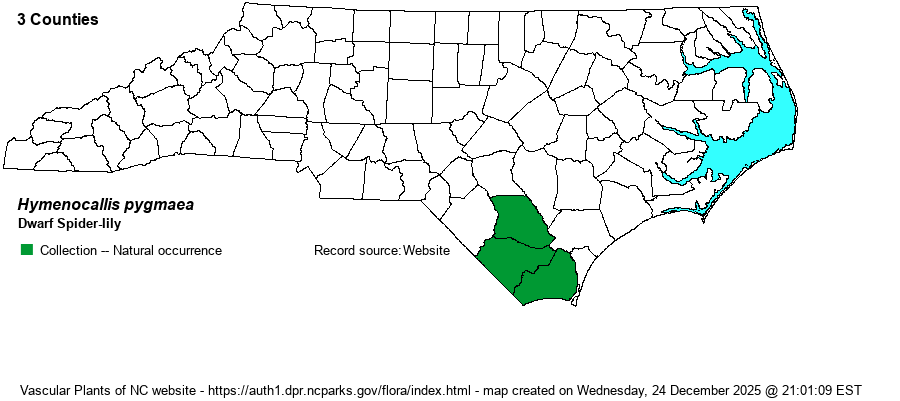| Author | Traub | |
| Distribution | Limited in the state to the extreme southeastern corner of the state, essentially only in the Waccamaw River drainage (Bladen, Columbus, and Brunswick counties). A report from a vegetation plot along a river in Pender County is considered by the website editors to be undocumented and may well refer to H. crassifolia, which is known from that county.
This is a very narrow endemic species, being limited to the Waccamaw drainage in the Carolinas, including the adjacent Pee Dee drainage in SC. It is known from only about 5-6 counties in its tiny range. | |
| Abundance | Though very rare in NC on the whole, along the Waccamaw River and tributaries it can be fairly common, as the NC NHP database contains 11 records for it in this limited area. Owing to its very small range, it is State listed as Special Concern. | |
| Habitat | This species is limited to the banks and edges of blackwater rivers and tributary streams. Note that H. crassifolia also can be found in these same habitats, and this larger and much more common species can occur in the same general area (though probably not with H. pygmaea). | |
| Phenology | Blooms in May and June, and fruits from June to July. | |
| Identification | This species is quite similar to the relatively numerous H. crassifolia, but is smaller in most dimensions, for which Weakley (2018) says "strikingly different in appearance from H. crassifolia". See the Identification characters for spider-lilies in the Hymenocallis crassifolia species account. H. pygmaea differs from its larger cousin by having shorter leaves, often just 1 foot to rarely 1.5 feet long, as opposed to 1.5-2 feet long in the other species; and by having smaller flowers, with the tepals (including the basal fused cup) only 2-2.5 inches long, as opposed to 3-4 inches or more in H. crassifolia. Fortunately for the observer, Dwarf Spider-lily can be seen from several bridges that cross the Waccamaw River or other large tributaries. If you have/had not already seen and become familiar with H. crassifolia, you might not realize you are looking at "pygmy" or "dwarf" spider-lilies, as a stand in full bloom is very showy. Note that RAB (1968) certainly had records of it subsumed within H. crassifolia. | |
| Taxonomic Comments | Various references treat this entity as a good species and other do not, yet essentially none treat it as a variety of H. crassifolia. Fortunately, the Flora of North America website does treat it as valid, as does Weakley (2018), whom this website follows. NatureServe does list it as a species but gives a Q to the rank to indicate Questionable taxonomy, a reasonable assessment.
| |
| Other Common Name(s) | Pygmy Spider-lily, Waccamaw Spider-lily | |
| State Rank | S1 | |
| Global Rank | G2Q | |
| State Status | SC-V | |
| US Status | | |
| USACE-agcp | | |
| USACE-emp | | |

